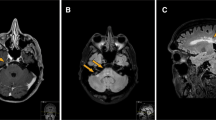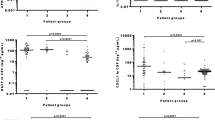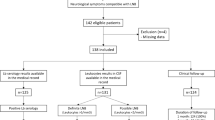Summary
Follow-up studies on 56 patients who suffered from antibiotically untreated, acute, monophasic neuroborreliosis five to 23 years ago revealed significant positive levels of IgG antibodies toBorrelia burgdorferi (Bb) in the serum and cerebrospinal fluid (CSF) of 20 patients (IFT, ELISA, Bb-specific IgG Western blot, Bb-specific IEF-IgG immunoblot). Nine of 10 tested patients had a definitely positive T-cell proliferative response to wholeB. burgdorferi, with a mean (±-SEM) stimulation index of 7.2±1.8. Because the patients studied exhibited no, or only mild to medium sequelae without any evidence of a chronic-progressive disease, we interpret the long-term persistence of specific T- and B-lymphocyte responses toB. burgdorferi as an “immunological scar syndrome”. Finally, diagnostic criteria of active neuroborreliosis are proposed.
Zusammenfassung
Verlaufsuntersuchungen von 56 Patienten, die vor fünf bis 23 Jahren an einer antibiotisch nicht behandelten, akuten monophasischen Neuroborreliose erkrankt waren, zeigten signifikant positive IgG-Antikörpertiter fürBorrelia burgdorferi im Serum und Liquor von 20 Patienten (IFT, ELISA,B. burgdorferi-spezifischer IgG-Westernblot,B. burgdorferi-spezifischer IEF-IgG-Immunoblot). Neun von zehn getesteten Patienten wiesen eine signifikant positive T-Zellproliferationsantwort gegenüber dem gesamtenB. burgdorferi-Antigen mit einem mittleren (±SEM) Stimulationsindex von 7.2±1.8 auf. Da die untersuchten Patienten keine oder nur leichte bis mittelgradige Residualsymptome ohne irgendeinen Hinweis auf eine chronisch-progressive Krankheit hatten, interpretierten wir die Langzeit-Persistenz der spezifischen T- und B-Lymphozytenantworten fürB. burgdorferi als ein “immunologisches Narbensyndrom”. Abschließend werden diagnostische Kriterien der aktiven Neuroborreliose vorgeschlagen.
Similar content being viewed by others
References
Krüger, H., Reuss, K., Pulz, M., Rohrbach, E., Pflughaupt, K.-W., Martin, R., Mertens, H. G. Meningoradiculitis and encephalomyelitis due toBorrelia burgdorferi: a follow-up study of 72 patients over 27 years. J. Neurol. 236 (1989) 322–328.
Magnarelli, L. A., Meegan, J. M., Anderson, J. F., Chappell, W. A. Comparison of an indirect fluorescent-antibody test with an enzyme-linked immuno-sorbent assay for serological studies of Lyme disease. J. Clin. Microbiol. 20 (1984) 181–184.
Dörries, R., ter Meulen, V. Detection and identification of virus-specific, oligoclonal IgG in unconcentrated cerebrospinal fluid by immunoblot technique. J. Neuroimmunol. 7 (1984) 77–89.
Martin, R., Martens, U., Sticht-Groh, V., Dörries, R., Krüger, H. Persistent intrathecal secretion of oligoclonal,Borrelia burgdorferi-specific IgG in chronic meningoradiculomyelitis. J. Neurol. 235 (1988) 229–233.
Wilske, B., Schierz, G., Preac-Mursic, V., Busch, K., Kühbeck, R., Pfister, H. W., Einhäupl, K. Intrathecal production of specific antibodies againstBorrelia burgdorferi in patients with lymphocytic meningoradiculitis (Bannwarth's syndrome). J. Infect. Dis. 153 (1986) 304–314.
Laemmli, U. K. Cleavage of structural proteins during the assembly of the head of bacteriophage T4. Nature 227 (1970) 680–685.
Blake, M. S., Johnston, K. H., Russel-Johnes, G. F., Gotschlich, E. C. A rapid sensitive method for detection of alkaline, phosphatase-conjugated anti-antibody on Western blots. Anal. Biochem. 136 (1984) 175–179.
Fleischner, B., Kreth, H. W. Clonal expansion and functional analysis of virus-specific T-lymphocytes from cerebrospinal fluid in measles encephalitis. Hum. Immunol. 7 (1983) 239–248.
Martin, R., Ortlauf, J., Sticht-Groh, V., Bogdahn, U., Goldmann, S. F., Mertens, H. G. Borrelia burgdorferi-specific and autoreactive T-cell lines from cerebrospinal fluid in Lyme radiculomyelitis. Ann. Neurol. 24 (1988) 509–516.
Schmidt-Wolf, I.: Humorale Antikörperbestimmung gegenBorrelia burgdorferi in drei verschiedenen Probandengruppen. Inaugural-Dissertation, Würzburg 1988.
Wilske, B., Preac-Mursic, V., Fuchs, R.: Immunodominant borrelia proteins for the humoral immune response in Lyme borreliosis. IV. International Conference on Lyme Borreliosis. Stockholm 1990, M/TU-P-38.
Bruckbauer, H. r., Wilske, B., Preac-Mursic, V., Fuchs, R.: Cross-reactive proteins ofB. burgdorferi. IV. International Conference on Lyme Borreliosis, Stockholm 1990, M/TU-P-39.
Volkman, D. J., Shepherd, D., Schultz, J., Gorevic, P. D., Dattwyler, R. J.: B. burgdorferi-specific T-cell responses: differences in antigen recognition in early and late infection. IV. International Conference on Lyme Borreliosis, Stockholm 1990, M/TU-P-28.
Yoshinari, N. H., Reinhardt, B. N., Steere, A. C.: T-cell proliferative responses to components ofB. burgdorferi in patients with Lyme arthritis. IV. International Conference on Lyme Borreliosis, Stockholm 1990, W-L-13.
Ackermann, R., Hörstrup, P., Schmidt, R. Tickbornemeningopolyneuritis (Garin-Bujadoux-Bannwarth). Yale J. Biol. Med. 57 (1984) 485–490.
Diringer, M. N., Halperin, J. J., Dattwyler, R. J. Lyme meningoencephalitis: Report of a severe penicillin-resistant case. Arthritis Rheum. 30 (1987) 705–708.
Hänny, P. E., Häuselmann, H. J. Die Lyme-Krankheit aus der Sicht des Neurologen. Schweiz. Med. Wochenschr. 117 (1987) 901–915.
Henriksson, A., Link, H. Prolonged IgM response within the central nervous system in lymphocytic meningoradiculitis (Bannwarth's syndrome). N. Engl. J. Med. 313 (1985) 1231.
Schaltenbrand, G. Durch Arthropoden übertragene Erkrankungen der Haut und des Nervensystems. Verh. Dtsch. Ges. Inn. Med. 72 (1967) 975–1005.
Gjestland, T. The Oslo study of untreated syphilis. Acta derm. venereol. (Stockh) 35 suppl. 34 (1955) 1–368.
Vandvik, B., Sköldenberg, B., Forsgren, M., Stiernstedt, G., Jeansson, S., Norrby, E. Long-term persistence of intrathecal virus-specific antibody responses after herpes simplex virus encephalitis. J. Neurol. 231 (1985) 307–312.
Henriksson, A., Link, H., Cruz, M., Stiernstedt, G. Immunoglobulin abnormalities in cerebrospinal fluid and blood over the course of lymphocytic meningoradiculitis (Bannwarth's syndrome). Ann. Neurol. 20 (1986) 337–345.
Prange, H. W., Moskophidis, M., Schipper, H. I., Müller, F. Relationship between neurological features and intrathecal synthesis of IgG antibodies toTreponema pallidum in untreated and treated human neurosyphilis. J. Neurol. 230 (1983) 241–252.
Dattwyler, R. J., Volkman, D. J., Luft, B. J., Halperin, J. J., Thomas, J., Golightly, M. G. Seronegative Lyme disease. Dissociation of specific T- and B-lymphocyte response toBorrelia burgdorferi. N. Engl. J. Med. 319 (1988) 1441–1446.
Pachner, A. R., Steere, A. C. CNS manifestations of third stage Lyme disease. Zentralbl. Bakteriol. Mikrobiol. Hyg. (A) 263 (1986) 301–306.
Broderick, J. P., Sandok, B. A., Mertz, L. E. Focal encephalitis in a young woman 6 years after the onset of Lyme disease: Tertiary Lyme disease? Mayo Clin. Proc. 62 (1987) 313–316.
Reik, L., Smith, L., Khan, A., Nelson, W. Demyelinating encephalopathy in Lyme disease. Neurology 35 (1985) 267–269.
Pachner, A. R., Steere, A. C. Neurologic involvement in the third stage of Lyme disease: CNS manifestations can mimic multiple sclerosis and psychiatric illness. Neurology 36 (Suppl. 1) (1986) 286.
Halperin, J. J., Luft, B. J., Anand, A. Lyme neuroborreliosis: central nervous system manifestations. Neurology 39 (1989) 753–759.
Halperin, J. J., Pass, H. L., Anand, A. K. Nervous system abnormalities in Lyme disease. Ann. NY Acad. Sci. 539 (1988) 24–34.
Pachner, A. R., Duray, P., Steere, A. C. Central nervous system manifestations of Lyme disease. Arch. Neurol. 46 (1989) 790–795.
Author information
Authors and Affiliations
Rights and permissions
About this article
Cite this article
Krüger, H., Martin, R., Sticht-Groh, V. et al. Long-term persistence of specific T- and B-lymphocyte responses to Borrelia burgdorferi following untreated neuroborreliosis. Infection 18, 263–267 (1990). https://doi.org/10.1007/BF01646998
Received:
Accepted:
Issue Date:
DOI: https://doi.org/10.1007/BF01646998




